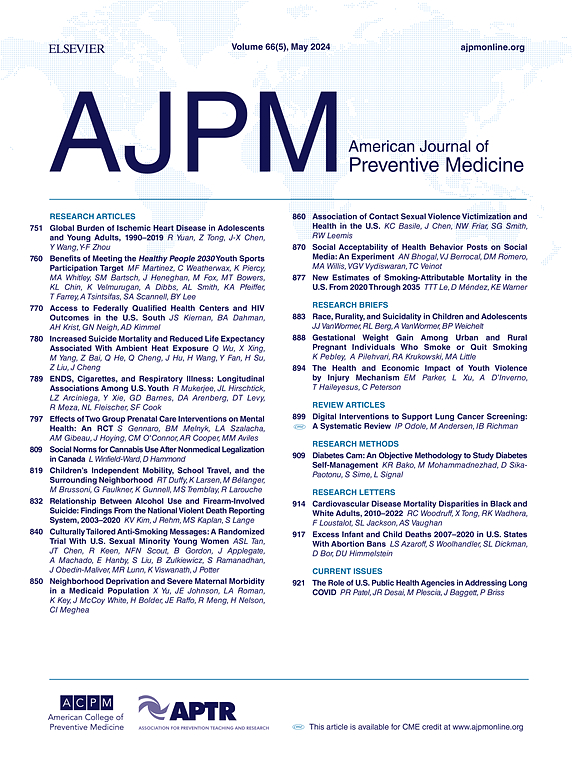从枪伤数量分析火器伤害的意图
IF 4.3
2区 医学
Q1 MEDICINE, GENERAL & INTERNAL
引用次数: 0
摘要
在枪支暴力预防研究中,一个复杂而持续的问题是正确分类伤害意图(例如,杀人、自杀或无意)。新兴的基于规则的方法改进了分类,在没有额外信息的情况下,使用子弹伤口的数量来推断伤害的意图。利用疾病控制和预防中心的国家暴力死亡报告系统(NVDRS),该系统从验尸官/法医报告、执法报告和死亡证明中获取有关火器伤害意图的详细信息,本研究检查了支持基于枪伤数量的意图判定的潜在证据。方法对2003年至2021年的NVDRS数据进行分析。采用方差分析(ANOVA)检验因故意造成的平均子弹伤数差异的统计学意义,采用Tukey’s Honest显著性差异检验确定因故意造成的具体差异。结果共发现致命火器伤299362例。平均枪伤数量因意图不同而有显著差异:自杀,1.02;他杀,2.72;非故意伤害为1.01 (p<0.01)。凶杀案死者的平均伤口数量明显高于非故意伤害死者和自杀死者(ΔM凶杀案-非故意伤害[1.71;95% ci =1.62, 1.79;p<;0.01]和ΔM凶杀-自杀[1.70;95% ci =1.68, 1.72;术;0.01])。结论子弹伤数量可能是区分火器伤害意图的有用指标,特别是在人际攻击中,当其他支持信息无法用于医学编码时。枪支故意伤害的准确计数对于公共卫生监督和预防规划至关重要。本文章由计算机程序翻译,如有差异,请以英文原文为准。
Characterizing Intent of Firearm Injuries by Number of Bullet Wounds
Introduction
A complex and ongoing issue in firearm violence prevention research is correctly classifying injury intent (e.g., homicide, suicide, or unintentional). Emerging rule-based approaches to improve classification use the number of bullet wounds to infer intent of the injury when additional information is not available. Using the Centers for Disease Control and Prevention’s National Violent Death Reporting System (NVDRS), which captures detailed information on intent of firearm injuries from coroner/medical examiner reports, law enforcement reports, and death certificates, this study examined potential evidence to support intent determination based on the number of bullet wounds.
Methods
2003–2021 NVDRS data on fatal firearm injuries was analyzed in 2023. ANOVA was used to test statistical significance of differences in average number of bullet wounds by intent, and Tukey’s Honest Significant Difference Test was used to determine specific differences by intent.
Results
A total of 299,362 fatal firearm injury decedents were identified. The average number of bullet wounds significantly differed by intent: suicide, 1.02; homicide, 2.72; and unintentional injury, 1.01 (p<0.01). Homicide decedents had a significantly higher average number of wounds than unintentional injury decedents and suicide decedents (ΔM homicide-unintentional injury [1.71; 95% CI=1.62, 1.79; p<0.01] and ΔM homicide-suicide [1.70; 95% CI=1.68, 1.72; p<0.01]).
Conclusions
The number of bullet wounds may be a useful indicator for classifying intent of firearm injuries, particularly for interpersonal assault, and when other supporting information is not available for medical coding. Accurate counts of firearm injuries by intent are critical for public health surveillance and prevention planning.
求助全文
通过发布文献求助,成功后即可免费获取论文全文。
去求助
来源期刊

American Journal of Preventive Medicine
医学-公共卫生、环境卫生与职业卫生
CiteScore
8.60
自引率
1.80%
发文量
395
审稿时长
32 days
期刊介绍:
The American Journal of Preventive Medicine is the official journal of the American College of Preventive Medicine and the Association for Prevention Teaching and Research. It publishes articles in the areas of prevention research, teaching, practice and policy. Original research is published on interventions aimed at the prevention of chronic and acute disease and the promotion of individual and community health.
Of particular emphasis are papers that address the primary and secondary prevention of important clinical, behavioral and public health issues such as injury and violence, infectious disease, women''s health, smoking, sedentary behaviors and physical activity, nutrition, diabetes, obesity, and substance use disorders. Papers also address educational initiatives aimed at improving the ability of health professionals to provide effective clinical prevention and public health services. Papers on health services research pertinent to prevention and public health are also published. The journal also publishes official policy statements from the two co-sponsoring organizations, review articles, media reviews, and editorials. Finally, the journal periodically publishes supplements and special theme issues devoted to areas of current interest to the prevention community.
 求助内容:
求助内容: 应助结果提醒方式:
应助结果提醒方式:


